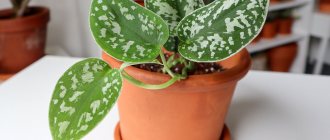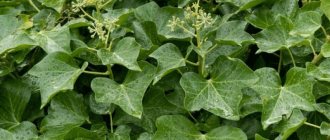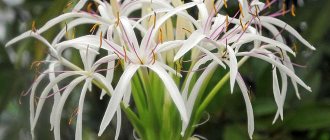Author's rating
Author of the article
Yakov Pavlovich
Professor, Head of the Department of Vegetable Growing
Articles written
153
Heather is a wild evergreen shrub that reaches 60-70 cm in height, has needle-like green leaves and blooms in original clusters of small bells. The plant can be wild or cultivated. Growing heather at home is a troublesome task; as the shrub develops in a pot, it becomes demanding. But if someone once grew this amazing plant in their home, then they remain a fan for life. Heather will be a spectacular decoration of any interior for months.
Pros and cons of growing heather at home
When growing heather at home, you may encounter nuances that have positive and negative sides.
The advantages include the following:
- Heather grown at home will give a natural, bright design to rooms, loggias or terraces.
- If the plant is grown at home, it guarantees flowering almost all year round - and evergreen bushes will decorate any interior.
- The flower looks great in original compositions with other indoor plants.
- Inflorescences with a subtle, delicate aroma, it will add a special charm to the atmosphere of the house.
The disadvantages include special care:
- Mandatory compliance with conditions under which the plant will be comfortable. Heather should be kept in a room at a certain temperature and humidity.
- It is necessary to properly water the flower and spray it.
- In order for the plant to always delight with its greenery and flowers, it needs to be renewed. After the heather flowering period, fertilizing is applied to its soil, then the bush is pruned. After this, next year, the plant will retain its attractiveness, splendor and aesthetic shape.
For gardeners, caring for your favorite plant will not be considered a minus, but will acquire the “rank” of special attention.
Frequently asked questions and answers
Gardeners who are just starting to grow heather find it difficult to cope with. It is necessary to know how and what to do at each stage of its growth, as well as other cultural features.
When does the plant bloom?
Heather flowering time is the end of August. Its great advantage is that even after the flowering period, the inflorescences do not fall off, but remain on the bush, so that the latter does not lose its decorative qualities for a very long time.
What to do after flowering?
At home, heather is often grown as an annual plant. In order for the bush to safely survive the winter and delight you with flowering again next year, appropriate feeding after flowering is necessary, as well as pruning. It is also important to keep the temperature low during the winter months.
What is the lifespan of a plant?
In the garden, heather can bloom for a long time - up to 5 years, while in nature its life is sometimes calculated in decades. But at home, this period is much shorter - 1 or even 2 years, if all the necessary conditions are created.
Why does heather dry out?
The heather dries out from lack of moisture. In dry seasons, you need to provide abundant watering, do not forget to also spray the plant, and humidify the air if possible. Also, the reason may lie in the soil, which has become slightly acidic. This requires appropriate feeding; for example, you can add acid along with water twice a year.
Despite the difficulties in planting and growing, heather remains one of the most interesting and useful plants. In addition to beautiful flowers that can be admired for a very long time, it is also used in medicine and cosmetology, and therefore is highly valued by gardeners.
Recommended varieties
Professionals recommend choosing the following varieties for growing on your window:
Ordinary
Common heather reaches up to 50 cm. The bush branches strongly. The color of the stems is bright with a reddish tint. Abundant flowers do not fall off for a long time after flowering has ended. A variety with delicate flowers of pink and lilac tones.
Wintering
An interesting variety reaches half a meter in height. It has large flowers up to 2 cm each, the color is snow-white; with abundant flowering, the plant fills the space with delicate light purity and “reflects” sunlight.
Slim
Heather is considered one of the brightest and most beautiful among indoor varieties. Compact bushes do not grow higher than 40 cm, the foliage is soft green. During the flowering period there is an abundance of inflorescences. Their color can be purple, pink, red. The last shade is reminiscent of pomegranate clusters.
Mix
The original variety attracts attention. Its flowers can be of different shades (white, pink, purple). The lush bush grows up to 50 cm and captivates with its delicate greenery and abundant flowering.
Description of the plant
Under natural conditions, heather is found throughout Europe, North America, Siberia, Africa, and the Azores. This shrub forms entire heaths, covered with a carpet of delicate and fragrant flowers. It belongs to the Heather family. The Latin name for heather is Calluna vulgaris. This plant has the following characteristics:
- This is a low or medium-sized plant with a height of 25–75 cm. It usually has many shoots with dense foliage, forming an elegant crown.
- Heather has gained its popularity among gardeners due to the fact that it remains green and elegant all year round.
- It has triangular light green leaves 0.5 cm long, curling into a tube at the edges.
- Heather flowers are pink or lilac oblong bells, collected in small clusters. They have a very pleasant smell, which is considered a distinctive feature of the plant.
- Flowering begins in June and ends in October. In autumn, the leaves change color from green to dark red and yellowish.
- The plant is considered a wonderful honey plant. It produces world-famous heather honey, which has unsurpassed taste and healing properties.
About 470 plant species are known, of which only 2 are suitable for growing indoors. These include:
Heather is slender. The height of the bush reaches 40 cm. It has light green leaves and bell-shaped flowers that grow at the ends of the side shoots and can have a variety of colors.
Heather is wintering. This plant is up to 0.5 m high with white flowers up to 2 cm long.
Unpretentious heather bushes are often grown at home. They are planted in pots and flowerpots installed on window sills, balconies and loggias. Care comes down to regular and timely watering of plants.
Conditions of detention
Typically, a flower lives shorter indoors than in open soil. As a rule, up to 2-3 years. But if grown correctly, beautiful heather can bloom continuously.
Lighting, temperature and humidity
This plant requires certain conditions for good development in the apartment. Heather should be installed in places well lit by the sun, but the plant does not tolerate high temperatures. It should not be placed near heating devices, radiators, or stoves.
The temperature in the room during the flowering period should be cool, no higher than + 120C, in summer no more than +250C, in winter +8+120C. The plant also requires constant ventilation and spraying, especially on hot days. Heather needs a lot of moisture; dry air will negatively affect the flower.
See also Potted lilies: planting and care at home
Soil and pot volumes
It is important to remember that for planting the pot must be spacious and deep, larger than the length of the heather root. As the flower grows, it should be transplanted into a larger pot. Large flowerpots and long boxes are ideal, where you can easily create bright compositions of heather. The soil should be chosen in the form of sandy, acidic or peaty substrates, humus - the plant is soil selective. Drainage is also necessary.
Heather at home in a pot - folk signs
Heather grows as a shrub in the wild in meadows and foothills. The shoots grow up to 80 cm long. The buds are small and purple in color. They resemble small bells. Observing certain conditions close to natural, you can start growing them in a pot at home.
Folk beliefs about growing heather in pots at home vary from country to country. In England, the presence of these green spaces in the house is considered lucky for the whole year. And the denser the heather thickets, the greater the happiness and prosperity in the family. In Northern and Central Europe, signs do not advise starting a flower at home. The appearance of lilac buds can cause the death of one of your loved ones. In Scandinavian countries, folk beliefs said that it is a symbol of female attractiveness. To have a flower at home meant to lure a man. In the old days, the Scandinavian Celts brewed potions from heather, which were a powerful love spell. In Slavic signs, its appearance in the house symbolized protection from evil spirits and negative energy.
Features of growing a flower
Growing heather at home is not easy, but interesting. Indoor heather is propagated in 3 ways:
- seeds;
- cuttings;
- dividing the bush.
You need to transplant seedlings into a pot in properly selected soil. It must contain peat and sand. Planting and caring for a plant at home requires compliance with certain rules. The main requirement for keeping heather in the house is to provide the plant with a well-ventilated, cool room.
Important! The flower does not tolerate heat well.
Therefore, during moderate temperatures in spring and autumn, you should take the plant in pots out into the fresh air on the balcony or in the yard. A stuffy, poorly ventilated room and direct sunlight negatively affect plant growth. In summer, the temperature of the flower is 15-23 degrees, and in winter – no more than 10-16 degrees. Heather should have plenty of light.
Watering must be carried out on time with warm water without chlorine, preventing the soil from drying out. In spring and autumn, the plant must be sprayed. Fertilizing is needed during the period of active growth; it must be fed with organic and mineral fertilizers. You need to feed a little, do not overdo it. Every year, carefully replant the bush into a larger pot, preserving the roots of the plant. The bush requires pruning, which should be done after the flowering period.
Planting and caring for indoor heather
The flower should be planted in a pot in the warm season - in spring, early summer, or in September-October. Comfortable temperature for heather growth is +18+220C, it gives better adaptation and development of roots.
Preparing the soil and seedlings
Since the plant loves acidic soils, it is necessary to acidify the soil before planting and then once a year. A good soil mixture for planting is peat/coniferous soil/river sand in a ratio of 3/2/1. Next (before planting) the soil is watered with heated clean water.
Depth and landing rules
When planting a plant, it is worth remembering that the root system must be completely covered with soil. Otherwise, it may be damaged and the heather will die. During planting, the bottom of the pot is filled with appropriate substrate so that the roots have room to grow. Next, carefully place the planting material in the pot, while it is advisable not to disturb the root system (in the earth coma). Then add the required amount of soil and water it with water.
Expert opinion
Stanislav Pavlovich
Gardener with 17 years of experience and our expert
Ask a Question
Important! When planting, the top layer of soil is not compacted, as this can damage the roots, which will negatively affect the entire plant.
Watering and spraying
It is recommended to water the plant 1-2 times every 7 days, under the roots, without getting on the foliage, in order to avoid gray rot. In winter, watering is reduced to a minimum. For irrigation, water should be allowed to settle so that it is freed from chlorine and warms up. You can use melted water or clean rainwater. Also, the flower must be sprayed regularly.
Fertilize the flower
Fertilizing should be done at the time of flowering using the root method. Complex universal liquid formulations and mineral fertilizers for ornamental plants are ideal. To acidify the soil, use sulfur or spruce bark.
Trimming and shaping
The plant should be cared for immediately after flowering. To do this, faded shoots are cut off, leaving no more than a third of the length. This prolongs the life of the plant, stimulates the heather to bloom again, making it more lush and bushy. Fresh stems are removed to create a neat bush shape. Woody stems will produce young shoots.
Wintering
For a safe wintering, the heather should be placed in a cool room with a temperature no higher than +80C. At the same time, you should monitor the condition of the soil and prevent it from drying out. Water the flower rarely and little. Insulated loggias and winter gardens are ideal.
Transfer
In order for the heather to feel as comfortable as possible, it should be replanted after a year. The renewed soil will give the plant everything it needs for growth and nutrition. Transplantation is carried out by transferring the plant with a lump of earth at the root; this minimally injures the flower.
Expert opinion
Stanislav Pavlovich
Gardener with 17 years of experience and our expert
Ask a Question
Important! It is better to replant the bush in the spring, when the plant is not yet blooming. It is better not to touch old plants.
Preparing the soil for planting
The soil must be acidic, this is one of the most important requirements , and the rest is not so critical, although it is better to give preference to a mixture of humus, peat and sand with the addition of sawdust or pine needles. Also, shortly before planting, it is recommended to additionally oxidize the soil with a special liquid: for 10 liters of water we take 100 grams of apple cider vinegar or citric acid, you can use 50 grams of electrolyte for batteries.
Read also: Champignons can be grown in manure because they
Before planting, carefully straighten the root system of each bush by hand so that the roots look outward and not inward - if this is not done, the heather will not be able to take root and will die. When planting, the root collar of the bush should be slightly higher than the ground, and lay drainage at the bottom of each hole. When planting in a pot, you need to take a container 5-6 cm wider than the rhizome and be sure to leave the “native” lump of earth on the roots. The ideal time for planting is from mid-April to early June.
If you decide to plant a flower with seeds, then remember that under indoor conditions, heather will bloom within two years. The seeds are sown on the surface of the ground and placed in a greenhouse (covered with film). In two to three weeks, seedlings will appear, which are transplanted into open ground, preferably in the spring, but it is also possible at the end of September. Plants that have just reached three years of age are pruned, being careful not to cut off the branches at the root.
Diseases and pests of crops
Heather is not very susceptible to diseases at home, however, some parasites and diseases can harm the plant if measures are not taken in time:
- With excessive watering, when water stagnates at the roots, gray rot occurs. It manifests itself in the form of white spots and growths on the heather, and the foliage begins to wither. Topaz or Fundazol will help cope with the problem. Experts recommend spraying the plant with a weak solution of copper sulfate for prevention.
- The nuisance of rust, which manifests itself as characteristic spots on the leaves, is eliminated by Topaz.
- Widespread powdery mildew “rewards” the plant with white and brown spots. It is also easy to overcome with the help of Fundazol.
- Pests in the form of spider mites are removed using Aktar and Actellik, and aphids are removed using Inta-Vira.
See also: The nuances of planting and caring for barberry bushes in open ground
Trouble can occur when infected with a virus, when the plant slows down, branches bend, and flowers and foliage change color. In this case, the heather cannot be saved, and to prevent it from infecting other flowers, it should be disposed of (burned).
Pests and their control
Heather has several enemies that must be carefully fought:
- Aphids (we use Decis, Intravira)
- Spider mite (we fight with Aktara and Aktellika)
- Gray rot (use Fundazol, Topaz, Rovral for it)
- Powdery mildew and rust - spray the bushes with copper preparations
If you create favorable conditions, the heather will grow wildly and decorate your home (or site) with beautiful colors and an extraordinary aroma. And knowing that this plant does not require special care methods, it is perfect not only for experienced gardeners, but also for beginners.
Features of reproduction
The plant can be grown from seeds, cuttings, or by dividing the root. Each method has its own characteristics. For home growing, a more suitable option is from seeds. Germination is excellent, up to 90%.
Seed method
This method is suitable for any season. The landing sequence is carried out in stages:
- Soil is laid out in a spacious container for drainage;
- water with warm water;
- loosen the soil;
- pour out seeds;
- add a layer of river sand (3 cm thick) and lightly water it.
The container is covered with film or glass, then placed in a warm and well-lit place. Shoots will appear in 3-4 weeks. During this time, the soil must be sprayed and ventilated to avoid drying out. Next, it will be very useful to take the seedlings out (for several hours) for “hardening” - on the balcony, terrace. Flowers are transplanted into pots for 8-10 months, when a strong root system is formed.
Important! For cuttings, you should choose the upper parts of heather. Experts do not recommend using flowering branches.
Cuttings
For this method, you can purchase ready-made cuttings for planting in the store, or prepare them yourself step by step:
- cut off a strong shoot 10 cm long with vegetative buds, preferably annual seedlings;
- place it in a container with a substrate of sand and peat;
- Root formation will take 4-5 weeks.
During cuttings, the container is regularly watered and the temperature is provided at +15+220C. The transplant to a permanent place should be done in a month. During this period, the roots will become strong.
Expert opinion
Stanislav Pavlovich
Gardener with 17 years of experience and our expert
Ask a Question
Important! Cuttings provide heather with more stable immunity to diseases and pests.
By dividing the rhizome
The plant can also be propagated by dividing the rhizome. It's simple and fast. The most suitable time for work is the beginning of autumn. In advance (3-4 weeks in advance), peat should be added to the root so that at the time of transplanting it, together with the neck, is completely immersed in the soil by 05-08 mm. This promotes rapid growth of the root system. The heather is dug up with a lump of earth, and the roots are carefully cut into equal parts. At the same time, they try to injure the heather as little as possible. Then the parts are planted in pots, watered and fed.
Reproduction methods
Heather can be propagated by seedlings and seeds, and both methods give good results. If you maintain the temperature regime at home, you can grow heather at any time of the year.
Seedlings
Reproduction using seedlings is a fairly quick and easy way. Cuttings for this purpose should be:
- flexible;
- with vegetative buds at the ends;
- annuals;
- no flowers;
- from the tops of the bushes.
It is recommended to plant them in special pots, in a peat-sand mixture. Choose autumn for breeding.
Seeds
Seeds are the most reliable way to propagate heather. Germination is 90%, and seed planting is less affected by the time of year. However, seeds require more time and labor than seedlings. Sowing occurs as follows:
- Water the finished soil with warm water.
- Place the seeds on the ground, lightly press them down and sprinkle soil on top.
- To prevent the soil from drying out, cover the pot with film.
The seeds germinate in about a month. You can also keep the seeds outside the ground, in cups or saucers. To do this, they are laid out in a container in a thin layer, watered with water and also hermetically sealed. After the first shoots appear, they are planted in pots.
The use of heather in folk medicine
In addition to decorative qualities (beautiful flowers, delicate greenery), heather also has medicinal properties, which are used in cosmetology and medicine. Infusions and decoctions of heather have anti-inflammatory, antibacterial properties and are effective against colds. In folk medicine, the plant is widely used in the treatment of cystitis, gout, liver and gall bladder.
Heather of legends and beliefs
In Scotland, there is an ancient legend about the appearance of heather bushes in this northern country. The Lord decided to decorate the cold desert steppes of Scotland a little. He turned to the oak tree, but the oak tree refused to settle there. The Lord went to honeysuckle, but it did not grow in cold conditions. The rose refused, citing the fact that its delicate petals would not withstand the northern winds. And only the heather did not refuse the Lord and the brave flower populated the northern lands of Scotland. For this, the Lord gave the plant bark that is as strong as oak, and the delicate scent of flowers like honeysuckle.
Therefore, the flower is still a symbol of perseverance in achieving the intended goal. And also sanity, which does not allow you to commit a rash act and stop in time. Beliefs say that a dried twig hidden in clothes will help you achieve success and keep you from doing stupid things.
Another Scottish legend tells about white heather. Its symbol was a Scottish princess who was waiting for her husband to return from the war. In memory of her beloved, she kept a snow-white silk scarf. The princess's loyalty and devotion were rewarded. The warrior returned safe and sound. Signs say that now white buds bring good luck and protect women from violence. Constantly wearing such a flower prolongs life, beauty and youth.
Preparing for landing
This indoor plant can be successfully propagated both by seeds and vegetatively. How to plant heather correctly? When replanting, you can divide the bush into several parts and plant it in separate pots - this is the fastest way. But for those who are not looking for easy ways, we advise you to try propagating heather with seeds. This activity is very exciting.
Seed selection
The seeds of this plant are tiny, even smaller than poppy seeds. They do not require stratification and can be sown both in winter and summer. Heather seeds are sown superficially, without digging into the soil.
Selecting a location
In summer, you can take the seedlings out onto the terrace or balcony so that they can soak up the free air and sun, but before that they need to be gradually hardened off and protected from direct sunlight and sudden temperature changes. Heather will give your balcony or window sill the charm of an alpine hill.
The most common method of propagation of this plant is by cuttings. Cuttings are harvested in August-September. Strong and robust plants are suitable for this, but they should not bloom at this time.
Choosing a pot
To root cuttings, prepare separate pots; even plastic cups will do.
Pour the soil mixture into the prepared cups. During rooting, plants must be moistened; do not allow the soil to dry out. Mature plants thrive in ceramic and plastic containers or pots.
Soil selection
Heather prefers acidic soils. Do not under any circumstances use soil liming. Heather dies on alkaline soil types. The soil mixture should contain pine needles, sand and some sawdust. Be sure to provide drainage to avoid stagnation of water in the root zone.
“Remember that the soil must be loosened and moist, rich in oxygen.”
Types and varieties
There is only one species in the genus - common heather (Calluna vulgaris). Very often, heather is called the related erica, as well as its types and varieties, but no matter how similar erics are to heather, they are still different plants. The common heather species is represented by a huge number of beautiful varieties - today there are about five hundred of them. Gardeners divide them into six groups.
Group one. Varieties of heather with green leaf color:
- Allegro is an evergreen shrub up to 60 cm high and a crown diameter of about half a meter. The bark is dark brown, the crown is dense, compact, the leaves are dark green, scale-like. It blooms from late July to late October with simple, shiny carmine-red flowers in long inflorescences. The variety is winter-hardy and requires shelter for the winter only when young;
- Carmen is a Dutch hybrid variety, most popular in Europe. The crown is rounded, the height of the bush is 30-40 cm, the bark is dark brown, the leaves are small, dark green, the flowers are simple, violet-pink, on peduncles more than 10 cm long. It is winter-hardy, but it is better to cover it for the winter.
In addition to the described varieties of this group, Radnor, Duckness, Ross Hutton, Mazurka, Marco, Barnett Enley, Hookstone and others are also popular.
Group two. Varieties with green leaves and white flowers.
- Alba is an erect bush up to 40 cm tall with a crown diameter of up to 55 cm, with ascending branches, bright green leaves and dense clusters of white flowers;
- Alexandra is a spherical bush up to 30 cm high and a crown diameter of up to 40 cm with dark green leaves and creamy flowers, which acquire a dark red hue towards the end of flowering.
The following varieties of the group are also known: White Lon, Humpty Dumpty, Long White, Alec Martin, Alba Jay and others.
Group three. Varieties with silver leaves.
- Silver Knight is an English variety up to 30 cm high and a crown diameter of up to 45 cm with a compact, pillow-shaped crown, dark brown bark, fluffy, silver-gray leaves that take on a burgundy hue in winter. The flowers are simple, lilac or light purple, inflorescences up to 20 cm long. Winter-hardy, but in cold winters requires shelter;
- Peter Sparks is also an English variety up to half a meter high and up to 60 cm in diameter. The crown is oval, the bark is dark brown, the leaves are small, scale-like, dark green in summer and autumn, and gray-green in spring and winter. The flowers are double, dark pink, densely collected in inflorescences up to 30 cm long. Moderately winter-hardy.
Also popular varieties of this group are Annmarie, Velvet Fashion, Jan Dekker, Glendwick Silver and others.
Fourth group. Varieties with golden leaves.
- When to prune grapes - in spring or autumn? Depends on whether the grapes overwinter under cover!
- Andrew Proudley - up to 15 cm high and about 25 cm in diameter with thin, widely ascending branches. The leaves, which are orange with pale yellow tips in warm weather, take on a bronze hue in winter. Small pink flowers are collected in loose inflorescences;
- Boskup is a Dutch variety up to 40 cm high, up to 50 cm in diameter with a compact crown, dark brown bark, yellow-green leaves in the summer, which turn copper-red in the fall. The flowers are simple, pink-lilac, collected in short, slightly branched inflorescences up to 10 cm long. Moderately winter-hardy.
The varieties Aura, Arran Gold, Blazeway, Crimson Sunset, Gold Hayes, Cottswood Gold and others are also of interest.
Fifth group. Varieties with double flowers.
- Autumn Glow is a spreading shrub up to 30 cm high and a crown diameter of about 45 cm with branches rising at the ends. The leaves are dark green, densely double light purple flowers are collected in short dense racemes;
- Monica is a wide-spreading bush with a diameter of up to 80 cm and a height of about 55 cm. The branches are strong, widely ascending, the leaves are dark green, with a gray coating in winter. Very large double flowers in dense clusters of pinkish-red hue.
Other popular varieties: Red Favorite, Dark Star, Alba Plena, Joan Sparks, County Wicklow.
Group six. Varieties with indehiscent flowers.
- David Eason - a spherical bush up to 20 cm high and a crown diameter up to 25 cm, with numerous ascending branches, dark green leaves and dark mauve flowers collected in short racemes;
- Marlin is a German variety up to 30 cm high, crown diameter up to 50 cm. The bark is dark brown, the leaves are small, dark green. The never-opening buds are bright purple or lilac-pink.
Other varieties: Romina, Minima, Fritz Kircher.
Flower propagation
It is carried out in various ways: by shifts, cuttings, tapping and dividing the bush:
- The process of growing from seeds is very labor-intensive and time-consuming, but it is often used by amateur gardeners, since seed germination is very high, more than 90%. The seeds are placed in a shallow container and covered with a thin layer of moistened substrate consisting of coniferous soil, high-moor peat and river sand in equal proportions. You can add a little more sand. Cover the container with film or glass until sprouts appear. The temperature of the seeds is about 20 °C. The first two weeks should be spent monitoring seed moisture, preventing the substrate from drying out. After about a month, the first shoots appear. Two weeks after the sprouts appear, the glass or film is removed and sprayed once every two weeks with soft water that does not contain chlorine and lime. After 9 months, the plants can be transplanted into separate pots with the prepared substrate described above. The diameter of the pot must be larger than the length of the roots and have good drainage, otherwise the flower will not be able to develop and will die. You can plant a bush in open ground only after it has taken root and adapted.
- The fastest way is propagation by dividing the plant during transplantation; this operation should be carried out in the fall, after flowering has ended. The roots are separated quite easily, the main condition is to preserve the soil around the roots containing the mycelium of soil fungi. The separated plants are planted in prepared holes or pots filled with the substrate described above.
- In nature, the plant successfully reproduces vegetatively. Adult bushes have developed side shoots that spread along the ground, which give roots and continue independent life, separating from the mother plant. At home, you just need to help the plant by digging up the emerging root formations, and you will get many new relics.
- When propagated by cuttings, the latter should be harvested in the fall, and only young shoots that do not contain flowers are cut. The cut cuttings are placed in a moist substrate similar to planting seeds and left until spring, watering and spraying with warm, soft water without chlorine. The maintenance regime is the same as for sprouted seeds. In the spring, cuttings with developed roots can be transplanted into open ground, having previously prepared a substrate known to you for them.
Related posts:
- “Bring me, father, a scarlet flower” or how to care for Vallota Vallota, aka Cirtanus or Krinum the Beautiful, perhaps it was the girl Nastenka who asked her as a gift from her father from far away...
- Beloperone with bright feather flowers seems to have come from a fictional world. Red, yellow, iridescent flowers of Beloperone growing indoors will attract so much attention that you will start it even a little...
- And where is it not used? A little more and they will call it Mega Prickly Pear. Opuntia (from Latin Opuntia) is the largest genus of the Cactus family. Most of its species consist of flat segments covered with tubercles (areoles) and...
- Cardamom is an unusual spice to grow at home. Should you grow an overseas spice on your windowsill? Nothing could be easier! Contents1 Description of the plant2 Where it grows3 Types4 Use5 Useful properties and…
- Turn your home into a resort! This is elementary with the Trachycarpus palm! The branched beauty, the Trachycarpus palm, will remind you of a hot southern resort even on the coldest winter evening. Bright fan leaves are spectacular...
The nuances of planting heather at home. Expert care tips
Heather is a plant blown by the winds, a plant of the tundra, Scottish heaths, a small evergreen relic, an inhabitant of peat bogs and deserted swamps.
You will certainly remember the soft lilac color of the inflorescences and the pleasant aroma; in addition, you will definitely appreciate the wide range of beneficial properties of heather. Do you want to have this miracle on your windowsill? We will tell you how to plant and grow heather at home.
Varieties for home cultivation
Only three varieties of this medicinal and highly decorative shrub are planted indoors:
- Heather is slender. The plant stands out for its beautiful appearance, its height is up to 40 cm. The leaf blades are distinguished by their rich light green color and have pubescence. During the flowering stage, heather attracts attention with its pink-red or purple bells, very similar to pomegranate seeds.
- Heather is wintering. Its height is 50 cm, the leaf blades are quite large, the flowers are white.
- Heather mix. On the territory of Russia, wintering heather and mixed heather are found in home floriculture much more often than slender heather. The height of the shrub is 40-50 cm, its highly branched stems are covered with scale-like leaf plates. The flowering phase occurs in July, the clusters consist of pink, purple and white bells.
Landing
If you don’t have time, then you shouldn’t even try to grow heather from seeds, because this is a very painstaking task. The fastest way to propagate is to divide the bush into several parts. Heather rhizomes divide well; to do this, you need to remove the plant from the pot and, without shaking off the soil or breaking the lump, divide it into three or four parts, plant them in separate containers and water them generously. After a few days, we recommend fertilizing with complex fertilizer.
The root formation process will take about two months. Rooted cuttings will delight you with flowering much earlier than seedlings that have sprouted from seeds.
All care comes down to timely watering, loosening the soil, fertilizing, and monitoring the pH of the soil solution. Regular spraying and ventilation will have a beneficial effect on the plant. Avoid high temperatures, especially during bud formation and flowering. Basic rules for caring for indoor heather:
- The main reason for the pain and weakness of heather is improper soil acidity.
- Heather is a lover of acidic soils.
- Add a handful of spruce needles to the pot, and soon you will notice how the plant will perk up, come to life and delight you with abundant flowering.
Features of care
At home, the principle of caring for any type of decorative heather is approximately the same, although some still require special conditions.
What should a gardener do and remember? How to care for heather at home?
- First of all, you will need a well-ventilated room in which the temperature in winter does not exceed +7-12°C (this condition is mandatory for the life of the plant and its flowering in winter).
- Heather does not tolerate heat very well.
- The plant must have enough light.
- Growing heather at home requires timely watering. The soil should always be moderately moist, and water can only be used for watering and spraying the plant if it has settled and contains a minimum amount of chlorine. Rain or melt is very suitable. When watering, you should try not to get it on the leaves of the bush, as otherwise it may begin to suffer from a disease such as gray rot.
- As a nutrient medium for growing the plant, it is recommended to take a mixture of marsh and coniferous soil, as well as sand and peat (parts ratio 3:1:½:1).
- Heather, which is a troublesome but fascinating task to care for at home, is very sensitive to fertilizing, so it should be fertilized very carefully so as not to overdo it. A full range of mineral fertilizers for heather is applied in the spring immediately after pruning. The fertilizer calculation is as follows - from 20 to 30 milligrams per square meter of soil.
- To stimulate growth and give shape, the bush must be pruned, while avoiding woody shoots, because it is from them that new branches begin to grow.
It is worth noting that common heather behaves unpretentiously at home - it is a completely unpretentious plant to plant and care for.
Planting heather in open ground
Where and when to plant
The best time for planting heather in open ground is from the end of September to the beginning of October and from the second half of April to the beginning of May, however, spring planting of heather is preferable to autumn. Heather loves open sunny areas, although it can grow in partial shade. Heather does not like calcareous soils, preferring dry sandy or moist peaty soils.
Heather does not pretend to make the soil fertile, but the pH value of the soil in the area should be shifted to the acidic side - pH approximately 4.5-5.5. The optimal soil composition for heather is peat, sand, coniferous soil or tree bark compost in a ratio of 3:1:2. The area where heather grows must be protected from strong winds. To acidify the soil, red high peat is added to it.
How to plant
Heather is planted at a density of approximately 6-10 specimens per 1 m², depending on the variety. The planting depth of the heather bush is 25-35 cm, the root collar should be flush with the surface of the site. If the soil on the site is clayey, in each hole you need to place a layer of drainage made of broken brick or sand with a layer of 5-10 cm. When planting heather, add 20-30 g of nitrophoska and 30-50 g of horn flour into the holes. After planting, water the heather seedlings at the rate of 5-6 liters of water for each heather bush and be sure to mulch the area with peat or coniferous wood chips. It remains to add that heather does not tolerate transplantation well, so try to think through all the steps and comply with all the requirements of agricultural technology so that the heather does not have to be replanted.
Properties of heather
The medicinal properties of heather are in demand in both folk and traditional medicine. It is used to treat cough, kidney disease, cystitis, pyelitis, urethritis, dysentery, diarrhea, gastritis, enterocolitis, rheumatism, gout, and skin diseases.
Blooming heather is harvested from the end of June to September - it is at this time that it contains the maximum amount of useful substances: flavonoids, mineral salts of phosphorus, potassium, calcium and sodium, organic acids. These substances give heather a disinfectant, anti-inflammatory, diaphoretic, wound-healing, diuretic, expectorant, cleansing, astringent and soothing effect.
Heather decoction is used for insomnia and nervous system disorders, vascular atherosclerosis, gastrointestinal diseases, hyperacidity, cholecystitis and obesity. Inflammation of the mouth and throat is relieved by rinsing with a decoction, and for tuberculosis, an alcoholic infusion of heather is taken internally. Powder from crushed heather flowers is used to treat ulcers, wounds, eczema and burns. Heather baths are prescribed for radiculitis. An infusion of heather flowers, rubbed into the scalp, slows down the process of hair loss and improves its appearance.
Heather has no contraindications, but before taking medications from it, it is better to consult with an experienced doctor. It is not recommended to use heather internally for people with low acidity of gastric juice.











